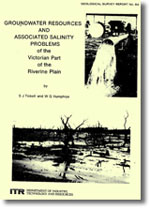GSV Report 84 - Groundwater resources and associated salinity problems of the Victorian part of the Riverine Plain
 |
| |||||||||||||||
Product description:Download The downloadable version of this report is supplied in PDF format (6MB). Abstract There is a complex of flat-lying aquifers and aquitards beneath the Riverine Plain through which groundwater moves both horizontally and vertically at varying rates. The deep regional aquifer - a composite of the Renmark Group and Calivil Formation aquifers - forms an extensive sheet of sand and gravel which underlies much of the Riverine Plain. It is highly transmissive and is the major aquifer system in the area. This is overlain by the Shepparton Formation which consists mainly of silty clay but contains varying proportions of sand beds from place to place which act as hydraulically interconnected aquifers. All aquifers contain good quality water close to the highlands, but to the north-west the quality becomes worse, even too saline for stock purposes. However, there is overall considerable scope for further development of the groundwater resource for urban and irrigation purposes. The salinity problem, which affects both streams and soil, has arisen from an increase in groundwater recharge through surface water irrigation and other agricultural practices such as widespread clearing of natural vegetation and replacement of this with shallow rooted crops and pastures. High water tables have become established under large parts of the irrigated areas. The Loddon Valley north of Serpentine is a zone of regional groundwater discharge causing serious land salinity problems and adversely affecting the quality of the Murray River via its contribution to Barr Creek. This zone undergoes rapid expansion during abnormally wet years. Elsewhere there is still a nett downward movement of groundwater to the deep regional aquifer but a similar equilibrium will probably be reached in the next 20 to 50 years, especially in the areas downstream from Rochester and Shepparton. The extent of high water tables and salinity problems will inevitably increase in the future with effects being worst towards the north west. Some dryland and low intensity irrigation areas will also be affected. With regard to physical conditions subsurface drainage is essential for maximum productivity in irrigation, but measures designed to reduce inputs to the water table should also be employed where practical in order to reduce the volume of saline effluent produced. In the long term, a proportion of this effluent must be removed from the area to avoid the inevitable build-up of salt in the upper part of the Shepparton Formation. Deep aquifer pumping may be a viable form of water-table control in dryland and low intensity irrigation areas, but is likely to be ineffective in high and moderate intensity irrigation areas. Considerable quantities of usable groundwater occur in the area. Its future use must be managed in a way which is compatible, both with salinity control and with its conservation as a renewable resource. Bibliographic reference Tickell, S.J. & Humphrys, W.G., 1987. Groundwater resources and associated salinity problems of the Victorian part of the Riverine Plain. Geological Survey of Victoria Report 84. Department of Industry Technology & Resources, Victoria. Related products:
| ||||||||||||||||


